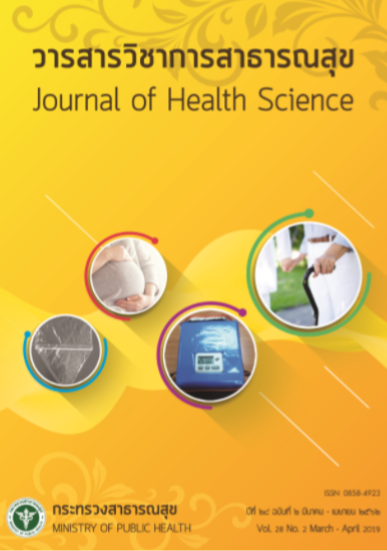Efficacy of Movement System Impairment (MSI) Therapy to Functional Performance and Severity of Knee Osteoarthritis (OA Knee) in Community-Dwelling Chronic OA Knee Patients, Lat Bua Luang District, Phra Nakhon Si Ayutthaya
Keywords:
osteoarthritis of knee (OA knee), knee pain, exercise, movement system impairment (MSI)Abstract
Osteoarthritis (OA) of knee is a common musculoskeletal problem that affect difficulty doing of activity daily life (ADL) in elderly people. Nowaday, Movement System Impairment (MSI) concept has several advantages for individuals with knee pain. MSI could reduce knee pain and improve capability level of ADL and quality of life. The objective of this study was to investigate effects of MSI therapy on functional outcomes and severity of OA knee in community-dwelling individuals with chronic osteoarthritis of knee. It was conducted with one group pretest-posttest design. Fifty-seven individuals with chronic OA knee participated in the present study. Time since OA knee of participants had been more than 6 months and they were recruited from the community in Ladbualuang District, Phra Nakhorn Si Ayudthaya Province during April 2016 – August 2017. There were three main steps of the procedures. Before performing MSI, the participants were evaluated by Oxford Knee Score and Knee and Osteoarthritis Outcome Score (KOOS) examinations. KOOS included 5 items: pain, symptoms, function in daily living, functional in sport and recreation, and knee-related quality of life. Then, each participant was asked to examine the physical musculoskeletal problem and received MSI therapy for 60 hours (1 hours per day, 4 days per week for 20 weeks). After completed MSI therapy, they received post-evaluation by using Oxford Knee Score and KOOS. Data were analyzed by following statistics: the descriptive statistics for characteristics and baseline data of participants; pair t-test for comparing mean of KOOS functional outcome scores; and the Wilcoxon Signed Rank test to compare Oxford Knee Score level as severity of OA knee between pre- and post-MSI therapy. The confidence interval and p-value were set at 95% and less than 0.05, respectively. It was found that fifty-seven participants completed MSI therapy. Most of the participants were female (75.43 percent) with aged range of 60-69 years (52.63 percent). After the MSI therapy, there was significant increase in all items of KOOS scores (p<0.001) and significant reduction of Oxford Knee Score level (p<0.001). In summary, MSI therapy could improve the functional activities that help reducing pain, symptoms, improve function in daily living, sport and recreation as well as knee-related quality of life. Moreover, it could reduce the severity of OA knee in community-dwelling chronic OA knee patients. The implications of MSI therapy have been encouragement of caring their knees and suitable application in their ADL. In addition, the participants had increased self-confidence in caring the knees, including prevention of knee overuse or misuse. Further study should be conducted to educate and follow-up patients with non-changed severity of the knee. In addition, MSI should be improved to attract OA knee patients as well as to promote regular follow-up examinations by physical therapists or care givers.
Downloads
Downloads
Published
How to Cite
Issue
Section
License
Copyright (c) 2019 Journal of Health Science - วารสารวิชาการสาธารณสุข

This work is licensed under a Creative Commons Attribution-NonCommercial-NoDerivatives 4.0 International License.







